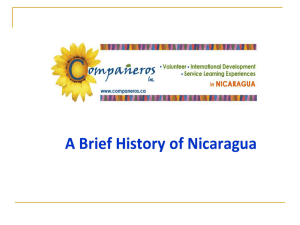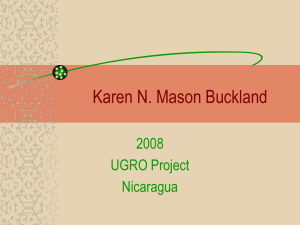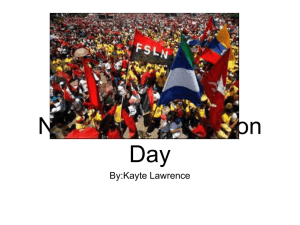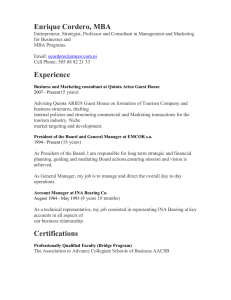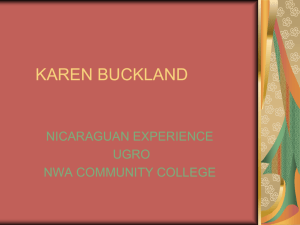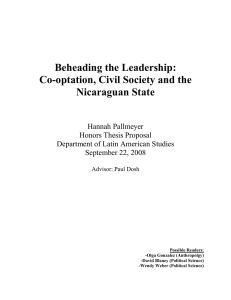Sandinismo, the Vanguardia and Nationalist Culture
advertisement
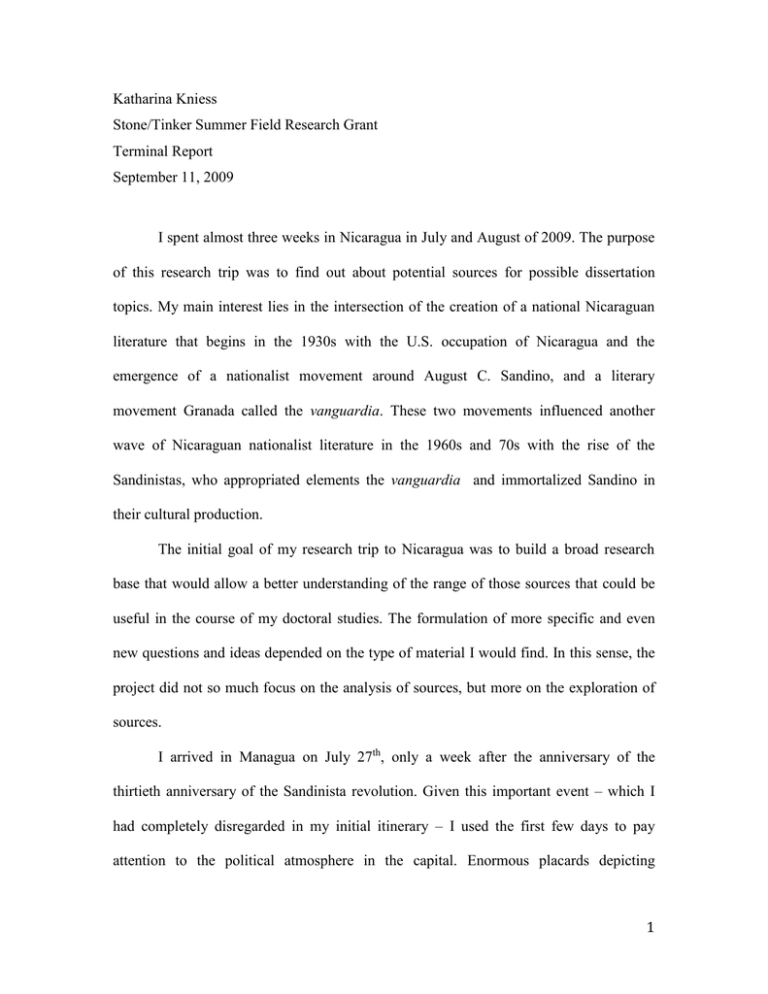
Katharina Kniess Stone/Tinker Summer Field Research Grant Terminal Report September 11, 2009 I spent almost three weeks in Nicaragua in July and August of 2009. The purpose of this research trip was to find out about potential sources for possible dissertation topics. My main interest lies in the intersection of the creation of a national Nicaraguan literature that begins in the 1930s with the U.S. occupation of Nicaragua and the emergence of a nationalist movement around August C. Sandino, and a literary movement Granada called the vanguardia. These two movements influenced another wave of Nicaraguan nationalist literature in the 1960s and 70s with the rise of the Sandinistas, who appropriated elements the vanguardia and immortalized Sandino in their cultural production. The initial goal of my research trip to Nicaragua was to build a broad research base that would allow a better understanding of the range of those sources that could be useful in the course of my doctoral studies. The formulation of more specific and even new questions and ideas depended on the type of material I would find. In this sense, the project did not so much focus on the analysis of sources, but more on the exploration of sources. I arrived in Managua on July 27th, only a week after the anniversary of the thirtieth anniversary of the Sandinista revolution. Given this important event – which I had completely disregarded in my initial itinerary – I used the first few days to pay attention to the political atmosphere in the capital. Enormous placards depicting 1 revolutionary heroes had been put up everywhere around town, but especially in the old city center called Los Escombros (The Ruins) for the state it was left in after the 1972 earthquake. These placards created a revolutionary continuity from the 1930s until today by showing Sandino, Carlos Fonseca, and finally President Daniel Ortega as the three links in an uninterrupted revolutionary history over the last thirty years. Placards with slogans such as “30 y seguimos cumpliendo” also suggested a continuous revolutionary path, disregarding the neoliberal years under Chamorro, Alemán and Bolaños from 19902004. In the following days I visited the Universidad Centroamericana (UCA) and specifically the Instituto de Historia de Nicaragua y Centroamérica. There I met with Prof. Leonel Delgado Aburto, who is an expert on Nicaraguan literary movements and whose work has focused on the vanguardia. Prof. Delgado gave me valuable bibliographical tips and advised me on what sources to look for. I found several secondary sources in the libraries and bookstores of UCA that traced the historical continuity of the revolution in literature since the 1930s. On the one hand I was happy to find this material, which was not accessible in the United States. On the other hand, my excitement was somewhat deflated when I discovered that much of the work on my topic had already been done. In the same week the opportunity arose to meet with Dr. Emilio Alvarez Montalván, former minister of foreign affairs under President Alemán. Dr. Montalván’s research focuses on Nicaraguan political culture, and having been born in 1919, he lived through most of the period I am interested in. Although my focus was on literature, I did not hesitate in using this opportunity to talk about political culture with such an important 2 figure. The conversation with Dr. Montalván turned out to be one of the most fruitful of my research trip. We talked about the current political situation in Nicaragua and Central America and how a particular political culture underlies the revolutionary history of Nicaragua. This led me to become interested in a new question: How is this political culture visible in Nicaraguan literature? In the second week of my stay in Nicaragua, I traveled to Granada, about an hour south of Managua. I visited the house of Pablo Antonio Cuadra, one of Nicaragua’s most important poets and other landmarks associated with the vanguardia. I also met with Professor Nicasio Urbina, former chair of the Spanish and Portuguese Department at Tulane University and a specialist in Nicaraguan literature. By now my research interest had broadened and the conversation with Prof. Urbina went in many disparate directions. Nevertheless, we talked about the feasibility of a project that combined literary and cultural studies with political sociology and Prof. Urbina recommended further secondary sources about this topic. Besides visiting relevant libraries and the archive of the IHNCA, as well as consulting scholars, I also used the opportunity of being in Nicaragua to travel around the country. Although I have been in Nicaragua many times, this is something I had never done with an “academic eye” and it was essential for getting a better feel for Nicaraguan culture. I would like to thank the Stone Center for Latin American Studies as well as the Tinker Foundation for this great chance of exploring Nicaragua intellectually and geographically. 3
